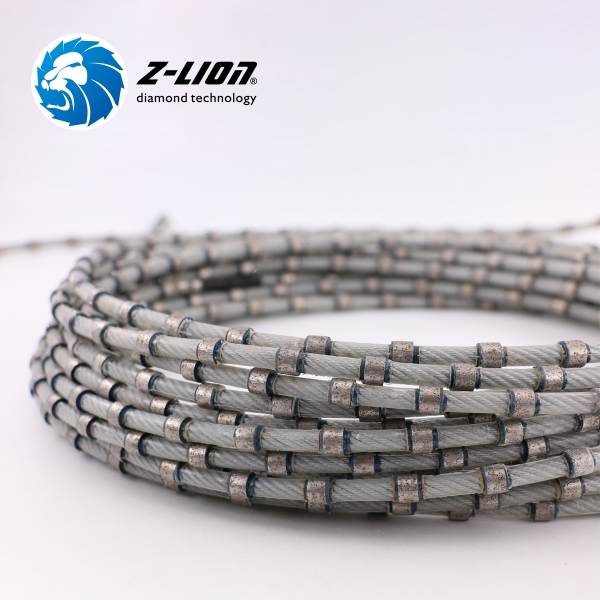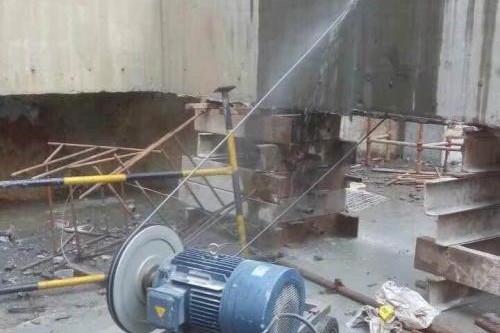
How to use diamond wire saw correctly?
The Basic Structure of Diamond Wire Saw
Diamond wire saws might seem like simple tools, but their effectiveness in cutting through tough materials like concrete and granite lies in their ingenious design. Let's delve deeper and explore the essential components that make up this powerful cutting machine.
The Core: The Diamond Bead
The heart of the diamond wire saw is the diamond bead. These small, tough beads are the workhorses of the operation. They are typically made with industrial diamonds, the hardest natural material known, embedded in a metal matrix. This combination provides exceptional cutting power while ensuring the beads can withstand the rigors of the sawing process.
The Foundation: The Steel Wire Rope
The diamond needs a strong and flexible carrier, which is where the steel wire rope comes in. This high-tensile cable forms the backbone of the saw, holding the diamond beads in place and allowing the entire assembly to be looped around the material to be cut.
The Finishing Touch: The Carrier Rings
The diamond beads are not directly attached to the wire rope. Instead, they are secured onto carrier rings that fit snugly around the cable. These rings can be attached using various methods, such as electroplating or sintering, ensuring the beads stay firmly in place during operation.
Understanding the Structure: The Power of Design
By combining these elements, diamond wire saws achieve a remarkable balance of strength, flexibility, and cutting efficiency. The continuous loop of diamond beads, held securely by the wire rope and carrier rings, allows the saw to tackle a wide range of materials and shapes. This design makes diamond wire saws a versatile and powerful tool for various industrial and construction applications.

Key Points for Using Diamond Wire Saws
1. Selecting the Right Wire
Matching the wire to the material: Diamond wire saws come with different diamond bead compositions, suited for various materials. For example, concrete cutting requires different beads than those used for cutting granite.
Wire diameter matters: Thicker wire ropes offer increased cutting power for tougher materials, but may be less maneuverable for intricate cuts. Choose a wire diameter that balances power with your cutting needs.
2. Correctly Install Diamond Wire Saw
Threading the Wire: Once you've planned the cutting path and created anchor points (drilled holes), carefully thread the diamond wire loop through the workpiece following the planned path.
Saw Installation: Mount the diamond wire saw unit according to the manufacturer's instructions. This typically involves securing the saw head to a track or frame that will guide the wire loop during cutting.
Anchoring the Ends: Secure both ends of the wire rope to the designated anchor points. This might involve specialized clamps or wedges provided with the saw system.
Creating Tension: Using the saw's tensioning mechanism (often hydraulic), gradually apply tension to the wire loop. The appropriate tension level will depend on the material being cut and the specific saw model. Refer to the manufacturer's manual for guidance.
3. Starting the Motor and Monitoring Operation
Pre-Start Checks:
Safety First: Double-check that all safety guards are in place and personnel are clear of the cutting area.
Component Verification: Ensure all saw components are properly installed and the wire loop is correctly threaded, tensioned, and anchored.
Power Supply: Verify the power supply is connected correctly and matches the saw's specifications.
Starting and Monitoring:
Start-Up: Once pre-start checks are complete, follow the manufacturer's instructions for starting the motor.
Monitor for Issues: While the saw is running, pay close attention to:
Vibration: Excessive vibration could indicate an unbalanced wire loop, loose components, or a problem with the saw unit itself.
Water Flow: Ensure a steady flow of coolant or water is being directed to the cutting zone.
Wire Condition: Monitor the wire for any signs of breakage or fraying.
Taking Action:
If any problems are found, stop the machine immediately. Turn off the motor and address the issue before restarting. This could involve adjusting the wire tension, checking for loose components, or troubleshooting water flow issues.
4. Cutting Techniques
Understanding the Workpiece:
Material Matters: The cutting speed and technique will vary depending on the material being cut. Harder materials may require slower cutting speeds and a more gradual approach.
Starting the Cut:
Slow and Steady: When initiating the cut, slowly engage the wire with the workpiece. Avoid applying excessive force at the beginning, allowing the diamonds to cut into the material gradually.
Maintaining Tension:
The Tight Balance: Monitor the wire tension throughout the cutting process. A wire that is too loose will cut inefficiently, while an excessively tight wire could damage the saw or the workpiece. Some saws may have tension monitoring features to assist you.
Cutting Angles:
Straight and Clean: Diamond wire saws are designed for straight cuts or controlled openings. Avoid attempting cuts at large angles, as this can put undue stress on the wire and potentially damage the workpiece.
5. Finishing Up
Power Down: Once the cut is complete, turn off the motor and disconnect the power supply following the manufacturer's instructions.
Cleaning Up:
Safety First: Before handling the wire or workpiece, ensure the saw is completely shut down and all moving parts have stopped.
Site Cleanup: Clear away debris and slurry from the cutting area to maintain a safe work environment.
Inspecting the Wire:
Wire Wear: After each use, visually inspect the diamond wire for signs of excessive wear, broken beads, or fraying.
Replacement: If the wire shows significant wear or damage, replace it with a new one to maintain optimal cutting performance.

Benefits of Using Diamond Wire Saw Correctly
1. Precision Cutting:
High Accuracy: Diamond wire saws excel at delivering exceptionally precise cuts. The thin, continuous wire allows for minimal material loss, resulting in clean and straight cuts.
Smooth Finish: The sawing process itself minimizes chipping or cracking, leaving a smooth and high-quality finished surface that often requires minimal additional finishing work.
2. Versatility and Efficiency:
Wide Range of Materials: Diamond wire saws can tackle a vast array of materials, including concrete, granite, steel, and even delicate materials like silicon wafers used in electronics.
Fast Cutting Speeds: Compared to traditional cutting methods, diamond wire saws can achieve significantly faster cutting speeds, especially for thick or deep cuts.
3. Safety and User-Friendliness:
Reduced Dust and Debris: The sawing process generates minimal dust and debris, creating a cleaner and safer working environment.
Controlled Demolition: Diamond wire saws offer a more controlled way to demolish structures or create openings compared to methods like jackhammers, which can cause vibrations and unpredictable damage.
Adaptable for Confined Spaces: The thin wire profile allows for sawing in tight spaces or reaching areas inaccessible to conventional saws.
Additional Benefits:
Reduced Noise Levels: Diamond wire saws generally operate at lower noise levels than other cutting tools.
Minimal Vibration: The sawing process produces minimal vibration, minimizing the risk of damage to surrounding structures.
By leveraging these benefits, diamond wire saws have become a valuable tool in various industries, including construction, demolition, mining, and renovation.
-
Online service
-
Official wechat
account
-
QQ:40933769
-
E-mail:
sales@z-lion.com
Online service
Please feel free to give your inquiry in the form below. We will reply you in 24 hours.

